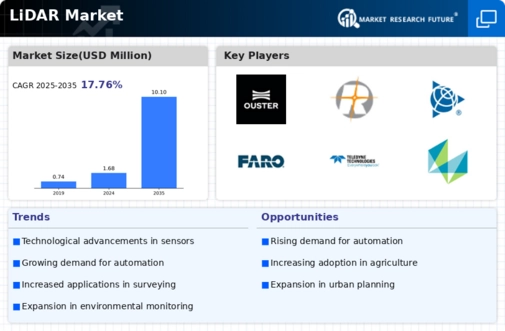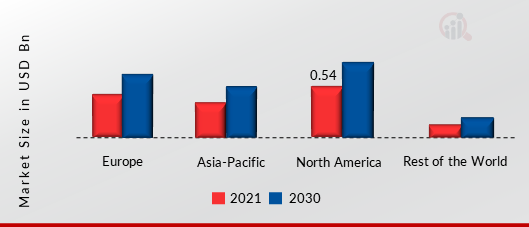-
Executive Summary
-
Market Introduction
-
Definition
-
Scope of the Study
-
List of Assumptions
-
Market Structure
-
Market Insights
-
Research Methodology
-
Research Process
-
Primary Research
-
Secondary Research
-
Market Size Estimation
-
Forecast Model
-
Market Dynamics
-
Introduction
-
Drivers
- Rising Demand for the 3D Imaging Technology
- Increased Adoption of LiDAR in Government Agencies
- Drivers Impact Analysis
-
Restraints
- High Installation Costs for LiDAR Systems
- Restraints Impact Analysis
- Opportunity
-
Market Factor Analysis
-
Value Chain Analysis
- Component Manufacturer
- System Integrators & Assemblers
- End–Users
-
Porters Five Forces Model
- Threat of New Entrants
- Bargaining Power of Suppliers
- Bargaining Power of Buyers
- Threat of Substitutes
- Intensity of Rivalry
-
Global LiDAR Market, by Product–Type
-
Overview
- Airborne LiDAR
- Terrestrial LiDAR
- Others
-
Global LiDAR Market, by Technology
-
Overview
- 1D
- 2D
- 3D
-
Global LiDAR Market, by Component
-
Overview
- Laser Scanner
- Navigation & Positioning Systems
- Other Component
-
Global LiDAR Market, by Functional Areas
-
Overview
- Engineering
- Corridor Mapping
- Environment
- ADAS & Driverless Car
- Urban Planning
- Cartography
- Meteorology
-
Global LiDAR Market, by Region
-
Introduction
-
North America
- US
- Canada
- Mexico
-
Europe
- Germany
- UK
- France
- Rest of Europe
-
Asia–Pacific
- China
- Japan
- India
- Rest of Asia–Pacific
-
Rest of the World
- Middle East & Africa
- Latin America
-
Competitive Landscape
-
Competitive Landscape
-
Company Profiles
-
Trimble Inc.
- Company Overview
- Financial Performance
- Product Offerings
- Key Developments
- SWOT Analysis
- Key Strategy
-
Faro Technologies Inc.
- Company Overview
- Financial Performance
- Products/Services/Solutions Offerings
- Key Developments
- SWOT Analysis
- Key Strategy
-
Teledyne Technologies, Inc. (Teledyne Optech Incorporated)
- Company Overview
- Financial Performance
- Products/Services/Solutions Offerings
- Key Developments
- SWOT Analysis
- Key Strategy
-
Hexagon AB (Leica Geosystems)
- Company Overview
- Financial Performance
- Products/Services/Solutions Offerings
- Key Developments
- SWOT Analysis
- Key Strategy
-
Beike Tianhui Technology Co., Ltd (Beijing Surestar Technology Co. Ltd)
- Company Overview
- Products/Services/Solutions Offerings
- Key Developments
-
Quantum Spatial
- Company Overview
- Products/Services/Solutions Offerings
- Key Developments
- Key Strategy
-
RIEGL Laser Measurement Systems GmbH
- Company Overview
- Products/Services/Solutions Offerings
- Key Developments
- SWOT Analysis
- Key Strategy
-
YellowScan
- Company Overview
- Products/Services/Solutions Offerings
- Key Developments
- Key Strategy
-
Geokno India Pvt. Ltd
- Company Overview
- Products/Services/Solutions Offerings
- Key Strategy
-
List of Tables
-
MARKET SYNOPSIS
-
LIST OF ASSUMPTIONS
-
GLOBAL LIDAR MARKET, BY PRODUCT–TYPE, 2024-2032 (USD MILLION)
-
GLOBAL LIDAR MARKET, BY TECHNOLOGY, 2024-2032 (USD MILLION)
-
GLOBAL LIDAR MARKET, BY COMPONENT, 2024-2032 (USD MILLION)
-
GLOBAL LIDAR MARKET, BY FUNCTIONAL AREAS, 2024-2032 (USD MILLION)
-
GLOBAL LIDAR MARKET, BY REGION, 2024-2032 (USD MILLION)
-
NORTH AMERICA: LIDAR MARKET, BY COUNTRY, 2024-2032 (USD MILLION)
-
NORTH AMERICA: LIDAR MARKET, BY PRODUCT–TYPE, 2024-2032 (USD MILLION)
-
NORTH AMERICA: LIDAR MARKET, BY TECHNOLOGY, 2024-2032 (USD MILLION)
-
NORTH AMERICA: LIDAR MARKET, BY COMPONENT, 2024-2032 (USD MILLION)
-
NORTH AMERICA: LIDAR MARKET, BY FUNCTIONAL AREAS, 2024-2032 (USD MILLION)
-
US: LIDAR MARKET, BY PRODUCT–TYPE, 2024-2032 (USD MILLION)
-
US: LIDAR MARKET, BY TECHNOLOGY, 2024-2032 (USD MILLION)
-
US: LIDAR MARKET, BY COMPONENT, 2024-2032 (USD MILLION)
-
US: LIDAR MARKET, BY FUNCTIONAL AREAS, 2024-2032 (USD MILLION)
-
CANADA: LIDAR MARKET, BY PRODUCT–TYPE, 2024-2032 (USD MILLION)
-
CANADA: LIDAR MARKET, BY TECHNOLOGY, 2024-2032 (USD MILLION)
-
CANADA: LIDAR MARKET, BY COMPONENT 2024-2032 (USD MILLION)
-
CANADA: LIDAR MARKET, BY FUNCTIONAL AREAS, 2024-2032 (USD MILLION)
-
MEXICO: LIDAR MARKET, BY PRODUCT–TYPE, 2024-2032 (USD MILLION)
-
MEXICO: LIDAR MARKET, BY TECHNOLOGY, 2024-2032 (USD MILLION)
-
MEXICO: LIDAR MARKET, BY COMPONENT, 2024-2032 (USD MILLION)
-
MEXICO: LIDAR MARKET, BY FUNCTIONAL AREAS 2024-2032 (USD MILLION)
-
EUROPE LIDAR MARKET, BY REGION, 2024-2032 (USD MILLION)
-
EUROPE LIDAR MARKET, BY PRODUCT–TYPE, 2024-2032 (USD MILLION)
-
EUROPE LIDAR MARKET, BY TECHNOLOGY, 2024-2032 (USD MILLION)
-
EUROPE LIDAR MARKET, BY COMPONENT, 2024-2032 (USD MILLION)
-
EUROPE LIDAR MARKET, BY FUNCTIONAL AREAS, 2024-2032 (USD MILLION)
-
GERMANY: LIDAR MARKET, BY PRODUCT–TYPE, 2024-2032 (USD MILLION)
-
GERMANY: LIDAR MARKET, BY TECHNOLOGY, 2024-2032 (USD MILLION)
-
GERMANY: LIDAR MARKET, BY COMPONENT, 2024-2032 (USD MILLION)
-
GERMANY: LIDAR MARKET, BY FUNCTIONAL AREAS, 2024-2032 (USD MILLION)
-
UK: LIDAR MARKET, BY PRODUCT–TYPE, 2024-2032 (USD MILLION)
-
UK: LIDAR MARKET, BY TECHNOLOGY, 2024-2032 (USD MILLION)
-
UK: LIDAR MARKET, BY COMPONENT, 2024-2032 (USD MILLION)
-
UK: LIDAR MARKET, BY FUNCTIONAL AREAS, 2024-2032 (USD MILLION)
-
FRANCE: LIDAR MARKET, BY PRODUCT–TYPE, 2024-2032 (USD MILLION)
-
FRANCE: LIDAR MARKET, BY TECHNOLOGY, 2024-2032 (USD MILLION)
-
FRANCE: LIDAR MARKET, BY COMPONENT, 2024-2032 (USD MILLION)
-
FRANCE: LIDAR MARKET, BY FUNCTIONAL AREAS, 2024-2032 (USD MILLION)
-
REST OF EUROPE: LIDAR MARKET, BY PRODUCT–TYPE, 2024-2032 (USD MILLION)
-
REST OF EUROPE: LIDAR MARKET, BY TECHNOLOGY, 2024-2032 (USD MILLION)
-
REST OF EUROPE: LIDAR MARKET, BY COMPONENT, 2024-2032 (USD MILLION)
-
REST OF EUROPE: LIDAR MARKET, BY FUNCTIONAL AREAS 2024-2032 (USD MILLION)
-
ASIA-PACIFIC LIDAR MARKET, BY REGION, 2024-2032 (USD MILLION)
-
ASIA-PACIFIC LIDAR MARKET, BY PRODUCT–TYPE, 2024-2032 (USD MILLION)
-
ASIA-PACIFIC LIDAR MARKET, BY TECHNOLOGY, 2024-2032 (USD MILLION)
-
ASIA-PACIFIC LIDAR MARKET, BY COMPONENT, 2024-2032 (USD MILLION)
-
ASIA-PACIFIC LIDAR MARKET, BY FUNCTIONAL AREAS, 2024-2032 (USD MILLION)
-
CHINA: LIDAR MARKET, BY PRODUCT–TYPE, 2024-2032 (USD MILLION)
-
CHINA: LIDAR MARKET, BY TECHNOLOGY, 2024-2032 (USD MILLION)
-
CHINA: LIDAR MARKET, BY COMPONENT, 2024-2032 (USD MILLION)
-
CHINA: LIDAR MARKET, BY FUNCTIONAL AREAS, 2024-2032 (USD MILLION)
-
JAPAN: LIDAR MARKET, BY PRODUCT–TYPE, 2024-2032 (USD MILLION)
-
JAPAN: LIDAR MARKET, BY TECHNOLOGY, 2024-2032 (USD MILLION)
-
JAPAN: LIDAR MARKET, BY COMPONENT, 2024-2032 (USD MILLION)
-
JAPAN: LIDAR MARKET, BY FUNCTIONAL AREAS, 2024-2032 (USD MILLION)
-
INDIA: LIDAR MARKET, BY PRODUCT–TYPE, 2024-2032 (USD MILLION)
-
INDIA: LIDAR MARKET, BY TECHNOLOGY, 2024-2032 (USD MILLION)
-
INDIA: LIDAR MARKET, BY COMPONENT, 2024-2032 (USD MILLION)
-
INDIA: LIDAR MARKET, BY FUNCTIONAL AREAS, 2024-2032 (USD MILLION)
-
REST OF ASIA-PACIFIC: LIDAR MARKET, BY PRODUCT–TYPE, 2024-2032 (USD MILLION)
-
REST OF ASIA-PACIFIC: LIDAR MARKET, BY TECHNOLOGY, 2024-2032 (USD MILLION)
-
REST OF ASIA-PACIFIC: LIDAR MARKET, BY COMPONENT, 2024-2032 (USD MILLION)
-
REST OF ASIA-PACIFIC: LIDAR MARKET, BY FUNCTIONAL AREAS 2024-2032 (USD MILLION)
-
REST OF THE WORLD LIDAR MARKET, BY REGION, 2024-2032 (USD MILLION)
-
REST OF THE WORLD: LIDAR MARKET, BY PRODUCT–TYPE, 2024-2032 (USD MILLION)
-
REST OF THE WORLD: LIDAR MARKET, BY TECHNOLOGY, 2024-2032 (USD MILLION)
-
REST OF THE WORLD: LIDAR MARKET, BY COMPONENT, 2024-2032 (USD MILLION)
-
REST OF THE WORLD: LIDAR MARKET, BY FUNCTIONAL AREAS, 2024-2032 (USD MILLION)
-
MIDDLE EAST & AFRICA: LIDAR MARKET, BY PRODUCT–TYPE, 2024-2032 (USD MILLION)
-
MIDDLE EAST & AFRICA: LIDAR MARKET, BY TECHNOLOGY, 2024-2032 (USD MILLION)
-
MIDDLE EAST & AFRICA: LIDAR MARKET, BY COMPONENT, 2024-2032 (USD MILLION)
-
MIDDLE EAST & AFRICA: LIDAR MARKET, BY FUNCTIONAL AREAS, 2024-2032 (USD MILLION)
-
LATIN AMERICA: LIDAR MARKET, BY PRODUCT–TYPE, 2024-2032 (USD MILLION)
-
LATIN AMERICA: LIDAR MARKET, BY TECHNOLOGY, 2024-2032 (USD MILLION)
-
LATIN AMERICA: LIDAR MARKET, BY COMPONENT, 2024-2032 (USD MILLION)
-
LATIN AMERICA: LIDAR MARKET, BY FUNCTIONAL AREAS, 2024-2032 (USD MILLION)
-
List of Figures
-
GLOBAL LIDAR MARKET: MARKET STRUCTURE
-
NORTH AMERICA MARKET SIZE & MARKET SHARE BY COUNTRY (2022 VS 2030)
-
EUROPE MARKET SIZE & MARKET SHARE BY COUNTRY (2022 VS 2030)
-
ASIA-PACIFIC & MARKET SHARE BY COUNTRY (2022 VS 2030)
-
REST OF THE WORLD MARKET SIZE & MARKET SHARE BY COUNTRY (2022 VS 2030)
-
RESEARCH PROCESS OF MRFR
-
TOP DOWN & BOTTOM UP APPROACH
-
DRO ANALYSIS OF GLOBAL LIDAR MARKET
-
DRIVER IMPACT ANALYSIS: GLOBAL LIDAR MARKET
-
RESTRAINTS IMPACT ANALYSIS: GLOBAL LIDAR MARKET
-
VALUE CHAIN: LIDAR MARKET
-
PORTER'S FIVE FORCES ANALYSIS OF THE GLOBAL LIDAR MARKET
-
GLOBAL LIDAR MARKET, BY PRODUCT–TYPE, 2024 TO 2032 (USD MILLION)
-
GLOBAL LIDAR MARKET, BY TECHNOLOGY, 2024 TO 2032 (USD MILLION)
-
GLOBAL LIDAR MARKET, BY COMPONENT, 2024 TO 2032 (USD MILLION)
-
GLOBAL LIDAR MARKET, BY FUNCTIONAL AREAS, 2024 TO 2032 (USD MILLION)
-
GLOBAL LIDAR MARKET, BY REGION, 2024 TO 2032 (USD MILLION)
-
NORTH AMERICA: LIDAR MARKET, BY COUNTRY, 2024-2032 (USD MILLION)
-
NORTH AMERICA: LIDAR MARKET, BY PRODUCT–TYPE, 2024 TO 2032 (USD MILLION)
-
NORTH AMERICA LIDAR MARKET, BY TECHNOLOGY, 2024 TO 2032 (USD MILLION)
-
NORTH AMERICA LIDAR MARKET, BY COMPONENT, 2024 TO 2032 (USD MILLION)
-
NORTH AMERICA LIDAR MARKET, BY FUNCTIONAL AREAS, 2024 TO 2032 (USD MILLION)
-
EUROPE LIDAR MARKET, BY REGION, 2024-2032 (USD MILLION)
-
EUROPE LIDAR MARKET, BY PRODUCT–TYPE, 2024 TO 2032 (USD MILLION)
-
EUROPE LIDAR MARKET, BY TECHNOLOGY, 2024 TO 2032 (USD MILLION)
-
EUROPE LIDAR MARKET, BY COMPONENT, 2024 TO 2032 (USD MILLION)
-
EUROPE LIDAR MARKET, BY FUNCTIONAL AREAS, 2024 TO 2032 (USD MILLION)
-
ASIA-PACIFIC: LIDAR MARKET, BY REGION, 2024-2032 (USD MILLION)
-
ASIA-PACIFIC LIDAR MARKET, BY PRODUCT–TYPE, 2024 TO 2032 (USD MILLION)
-
ASIA-PACIFIC LIDAR MARKET, BY TECHNOLOGY, 2024 TO 2032 (USD MILLION)
-
ASIA-PACIFIC LIDAR MARKET, BY COMPONENT, 2024 TO 2032 (USD MILLION)
-
ASIA-PACIFIC LIDAR MARKET, BY FUNCTIONAL AREAS, 2024 TO 2032 (USD MILLION)
-
REST OF THE WORLD LIDAR MARKET, BY REGION, 2024-2032 (USD MILLION)
-
REST OF THE WORLD: LIDAR MARKET, BY PRODUCT–TYPE, 2024 TO 2032 (USD MILLION)
-
REST OF THE WORLD: LIDAR MARKET, BY TECHNOLOGY, 2024 TO 2032 (USD MILLION)
-
REST OF THE WORLD: LIDAR MARKET, BY COMPONENT, 2024 TO 2032 (USD MILLION)
-
REST OF THE WORLD: LIDAR MARKET, BY FUNCTIONAL AREAS, 2024 TO 2032 (USD MILLION)
-
BENCHMARKING OF MAJOR COMPETITORS
-
"










Leave a Comment